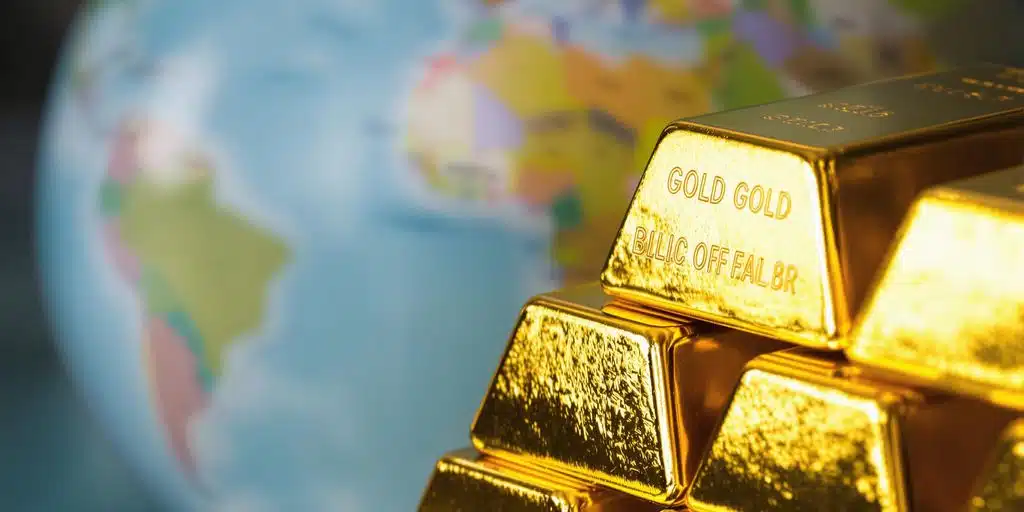
Is Gold Shaping A New World Order?
Is Gold Shaping a New World Order?
By Syed Duha and Saifullah Bashir
The post-1945 financial order was built on the belief that global systems were apolitical: the money, markets, and networks functioned on neutrality. That belief no longer holds true.
Payment systems can now be weaponised, reserves can be blocked, and algorithms can enforce sanctions faster than diplomats can draft them.
ADVERTISEMENTIn the shifting terrain of global finance, sovereignty is being silently redefined by gold reserves. Gold has re-emerged as the most elemental form of security which is solid, neutral, and beyond manipulation.
The recent surge in gold prices crossing $3,500 an ounce in 2025 and projected to touch $4,100 by 2026 is not merely a market phenomenon. It is a political signal.
For decades, the U.S. dollar anchored the world economy, offering both convenience and control. But when financial systems were restricted and sanctioned after geopolitical conflicts, the illusion of neutrality vanished.
Holding dollars came to mean holding conditional power where wealth could be rendered inaccessible overnight.
It is this loss of certainty that has made the solidity of gold newly attractive. The world is, thus in effect, rewriting the grammar of sovereignty, and gold is becoming its new syntax.
Central banks have taken note. Between 2023 and 2024, they purchased more than a thousand tonnes of gold: the fastest accumulation in modern history. This is not a speculative rush but a structural correction, a hedge against the weaponisation of finance.
IMF data reveals that the dollar's share of global reserves fell from 65 per cent in 2016 to below 58 per cent in 2024. In the same period, gold's share rose sharply, particularly among emerging economies.
A 2022 IMF report titled“The Stealth Erosion of Dollar Dominance” observed that the dollar's share in reserves declined from 71 per cent in 1999 to 59 per cent in 2021.
“If dollar dominance ends,” the IMF concluded,“it will not be replaced by a single currency, but by a collection of alternatives.”
The trust that once converged on the dollar is now dispersing across multiple assets. Central banks are quietly diversifying their holdings, adding euros, yen, and smaller but stable currencies.
Meanwhile, gold's share in foreign exchange reserves is rising. Emerging markets now keep about 9 percent of reserves in gold, more than double the 4 percent a decade ago.
For developed markets, the figure stands near 20 percent. And gold, sitting outside this competition, gains value precisely because it belongs to no one.
This slow rearrangement is visible even within the old foundations of the global system. The petrodollar order, which once tied oil and power to the dollar's supremacy, is being silently rewritten.
Saudi Arabia, which has long been the guarantor of that system, increased its gold holdings by 9 percent in 2024, reaching 15.4 tonnes, the highest level since 2014.
The move is not symbolic. It coincides with Riyadh's $6.9 billion currency swap agreement with China, designed to facilitate trade in local currencies, and the rollout of its digital riyal under the mBridge project, which is a cross-border payment experiment using central bank digital currencies.
These shifts may look technical, but they point to something profound: a steady effort to diversify exposure and regain monetary agency.
The dollar is still the anchor, but its grip is loosening.
India's direction appears similar but carries its own context. The Reserve Bank of India's latest data shows gold reserves crossing 102 billion dollars, up by 3.595 billion dollars, marking the highest share in India's reserves since 1997.
Gold now makes up 14.7 percent of the total reserve basket. The increase is not dramatic but deliberate. It signals a desire for buffers in the world of volatile trust.
India isn't part of the loud de-dollarization talk. The approach is pragmatic: expanding the UPI network across borders, testing the digital rupee step by step, and pushing trade in local currencies where it fits.
Each initiative, in its own way, adds flexibility to financial sovereignty. India remains within the system but tries not to be trapped by it.
Within BRICS and the Shanghai Cooperation Organisation, India engages with alternative payment networks but stops short of endorsement.
Gold fits naturally in this middle path. Its growing share in Indian reserves offer an understanding of stability and caution in a shifting world order.

Legal Disclaimer:
MENAFN provides the
information “as is” without warranty of any kind. We do not accept
any responsibility or liability for the accuracy, content, images,
videos, licenses, completeness, legality, or reliability of the information
contained in this article. If you have any complaints or copyright
issues related to this article, kindly contact the provider above.


















Comments
No comment